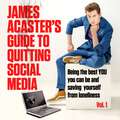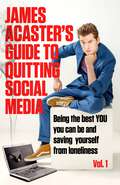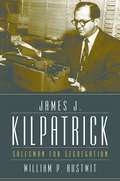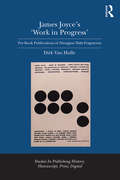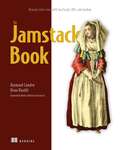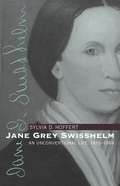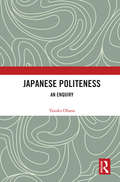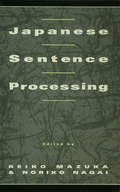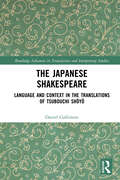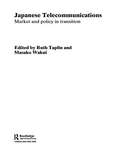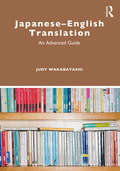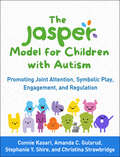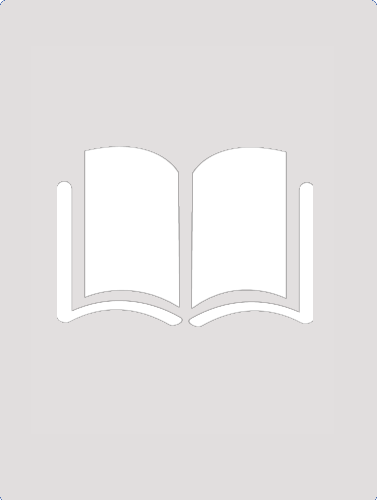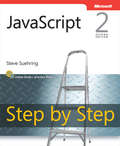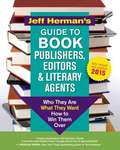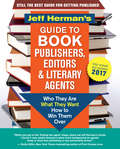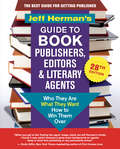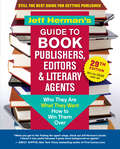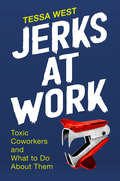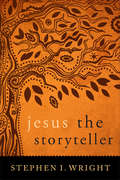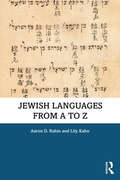- Table View
- List View
James Acaster's Guide to Quitting Social Media
by James AcasterThis is a self help book like no other. Because you are not helping yourself, James Acaster is helping you.When James quit all forms of social media in 2019 he felt like he'd been born anew, but he was worried he'd suffer withdrawal and get lured back online to compete in a never ending popularity contest with only one possible winner (f*cking Zuckerberg). He knew that in order to stay clean he'd have to replace everything social media used to give him with three-dimensional, real-life activities. And so it was that James found ways to anonymously bully strangers, see photos of everyone's dogs, get invited to as many parties as possible, immediately know about all celebrity deaths, get public figures fired, argue with everybody about everything, and so much more without even owning a phone (he painted over the screen of his old one to stop himself looking at Instagram). His life is amazing and yours could be too if you buy JAMES ACASTER'S GUIDE TO QUITTING SOCIAL MEDIA, BEING THE BEST YOU YOU CAN BE AND SAVING YOURSELF FROM LONELINESS VOL. 1. You will also need to do everything the audiobook tells you to. Including helping us promote the audiobook by tweeting about it.(P) 2022 Headline Publishing Group Ltd
James Acaster's Guide to Quitting Social Media
by James AcasterThis is a self-help book like no other. Because you are not helping yourself, James Acaster is helping you.In 2019, James quit all forms of social media - covering his phone in tar and driving it to a lock-up in Rhyl, before setting up home in a castle he'd built himself called Castle Anti-Net. But when the withdrawal symptoms hit him, he realised in order to stay clean he'd have to replace everything social media gave him with three-dimensional, real-life activities. Employing the help of a mysterious, wealthy benefactor named Clancy Dellahue, and an ever-growing gang of misfits (aka the Tangfastic Crew), James found ways to replace his online friends (he joined the scouts) and spy on his exes (climbing ropes, zip lines, fake moustache) as well as anonymously bullying strangers, seeing photos of everyone's dogs, getting public figures fired, arguing with everybody about everything, and so much more. His life is amazing and yours could be too if you buy JAMES ACASTER'S GUIDE TO QUITTING SOCIAL MEDIA, BEING THE BEST YOU YOU CAN BE AND SAVING YOURSELF FROM LONELINESS VOL. 1.
James Acaster's Guide to Quitting Social Media
by James AcasterThis is a self-help book like no other. Because you are not helping yourself, James Acaster is helping you.In 2019, James quit all forms of social media - covering his phone in tar and driving it to a lock-up in Rhyl, before setting up home in a castle he'd built himself called Castle Anti-Net. But when the withdrawal symptoms hit him, he realised in order to stay clean he'd have to replace everything social media gave him with three-dimensional, real-life activities. Employing the help of a mysterious, wealthy benefactor named Clancy Dellahue, and an ever-growing gang of misfits (aka the Tangfastic Crew), James found ways to replace his online friends (he joined the scouts) and spy on his exes (climbing ropes, zip lines, fake moustache) as well as anonymously bullying strangers, seeing photos of everyone's dogs, getting public figures fired, arguing with everybody about everything, and so much more. His life is amazing and yours could be too if you buy JAMES ACASTER'S GUIDE TO QUITTING SOCIAL MEDIA, BEING THE BEST YOU YOU CAN BE AND SAVING YOURSELF FROM LONELINESS VOL. 1.
James J. Kilpatrick
by William P. HustwitJames J. Kilpatrick was a nationally known television personality, journalist, and columnist whose conservative voice rang out loudly and widely through the twentieth century. As editor of the Richmond News Leader, writer for the National Review, debater in the "Point/Counterpoint" portion of CBS's 60 Minutes, and supporter of conservative political candidates like Barry Goldwater, Kilpatrick had many platforms for his race-based brand of southern conservatism. In James J. Kilpatrick: Salesman for Segregation, William Hustwit delivers a comprehensive study of Kilpatrick's importance to the civil rights era and explores how his protracted resistance to both desegregation and egalitarianism culminated in an enduring form of conservatism that revealed a nation's unease with racial change.Relying on archival sources, including Kilpatrick's personal papers, Hustwit provides an invaluable look at what Gunnar Myrdal called the race problem in the "white mind" at the intersection of the postwar conservative and civil rights movements. Growing out of a painful family history and strongly conservative political cultures, Kilpatrick's personal values and self-interested opportunism contributed to America's ongoing struggles with race and reform.
James Joyce's 'Work in Progress': Pre-Book Publications of Finnegans Wake Fragments (Studies in Publishing History: Manuscript, Print, Digital)
by Dirk Van HulleThe text of Finnegans Wake is not as monolithic as it might seem. It grew out of a set of short vignettes, sections and fragments. Several of these sections, which James Joyce confidently claimed would "fuse of themselves", are still recognizable in the text of Finnegans Wake. And while they are undeniably integrated very skillfully, they also function separately. In this publication history, Dirk Van Hulle examines the interaction between the private composition process and the public life of Joyce's 'Work in Progress', from the creation of the separate sections through their publication in periodicals and as separately published sections. Van Hulle highlights the beautifully crafted editions published by fine arts presses and Joyce's encouragement of his daughter's creative talents, even as his own creative process was slowing down in the 1930s. All of these pre-book publications were "alive" in both bibliographic and textual terms, as Joyce continually changed the texts in order to prepare the book publication of Finnegans Wake. Van Hulle's book offers a fresh perspective on these texts, showing that they are not just preparatory versions of Finnegans Wake but a 'Work in Progress' in their own right.
The Jamstack Book: Beyond static sites with JavaScript, APIs, and markup
by Raymond Camden Brian RinaldiJamstack = JavaScript, APIs, and Markup. Use established standard technologies to build super-fast static websites without sacrificing rich, dynamic features.In The Jamstack Book, you will learn how to: Use different static site generators to build websites Deploy Jamstack sites with 11ty, Next.js, Hugo, and Jekyll Add dynamic capabilities like form processing and eCommerce Enhance your Jamstack site with serverless capabilities Integrate a CMS with a Jamstack site Jamstack sites use JavaScript, APIs, and Markup to create fast, dynamic pages without the overhead of heavyweight frameworks. The Jamstack Book is your essential guide to this exciting new web architecture. Written by renowned Jamstack experts Raymond Camden and Brian Rinaldi, it&’s filled with real-world projects to develop and hone your skills. You&’ll learn how to lay out and generate a site, set up your own CMS, and add dynamic features like user logins and search functionality. Confusing jargon is demystified. Plus, you&’ll get the chance to try out different static site generators and find the one that works best for you. Pick up this book today, and you&’ll discover how the Jamstack answers your need for speed and simplicity. About the technology JavaScript, APIs, and pre-rendered Markup put the JAM in Jamstack. This modern web architecture delivers the quick load times of static sites along with the dynamic functionality you need for user-friendly interactive features. Built with lightweight standards and tools, Jamstack sites are fast, secure, easy to maintain, and naturally optimized for mobile and SEO. About the book The Jamstack Book teaches effectively by creating a portfolio of sites, ranging from a simple blog to an eCommerce store. Each new project introduces important skills, including cloud deployment, user logins, and search. You&’ll get hands-on experience with tools like 11ty, Next.js, and Netlify. As your skills grow, the examples become more sophisticated, including serverless technology, dynamic forms, and an integrated CMS. What's inside Use different static site generators to build websites Add dynamic capabilities like form processing and eCommerce Enhance your Jamstack site with serverless capabilities Integrate a CMS with a Jamstack site About the reader For web developers and CMS site developers. About the author Raymond Camden is the author of multiple books on web development and has been blogging and presenting for almost twenty years. Brian Rinaldi has been involved in static site and Jamstack development since the early days. Table of Contents 1 Why Jamstack? 2 Building a basic Jamstack site 3 Building a blog 4 Building a documentation site 5 Building an e-commerce site 6 Deployment 7 Adding dynamic elements 8 Working with serverless computing 9 Adding a content management system 10 Migrating to the Jamstack
Jane Grey Swisshelm: An Unconventional Life, 1815-1884
by Sylvia D. HoffertNineteenth-century newspaper editor Jane Grey Swisshelm (1815-1884) was an unconventionally ambitious woman. While she struggled in private to be a dutiful daughter, wife, and mother, she publicly critiqued and successfully challenged gender conventions that restricted her personal behavior, limited her political and economic opportunities, and attempted to silence her voice. As the owner and editor of newspapers in Pittsburgh; St. Cloud, Minnesota; and Washington, D.C.; and as one of the founders of the Minnesota Republican Party, Swisshelm negotiated a significant place for herself in the male-dominated world of commerce, journalism, and politics. How she accomplished this feat; what expressive devices she used; what social, economic, and political tensions resulted from her efforts; and how those tensions were resolved are the central questions examined in this biography. Sylvia Hoffert arranges the book topically, rather than chronologically, to include Swisshelm in the broader issues of the day, such as women's involvement in politics and religion, their role in the workplace, and marriage. Rescuing this prominent feminist from obscurity, Hoffert shows how Swisshelm laid the groundwork for the "New Woman" of the turn of the century.
Japanese Politeness: An Enquiry
by Yasuko ObanaAlthough Japanese language is one of the most quoted examples in politeness research, extant publications focus on particular areas of politeness, and very few of them enquire into varied aspects of Japanese politeness. In this book, Yasuko Obana provides an integrated account of what signifies Japanese politeness. By examining how far previous assumptions can apply to Japanese, Obana exposes a variety of characteristics of Japanese politeness. By taking a diachronic approach, she probes into what constitutes politeness, extracts key elements of the term ‘polite’ in Japanese, and demonstrates how modern honorifics’ apparent diverse, divergent uses and effects can be integrated into a systematic matrix. Furthermore, by quoting traditional Japanese language scholars’ (kokugo gakusha) studies, Obana brings different views into the open. She also carves out politeness strategies in Japanese that have not been adequately explored to date. They often conform to the way in which honorifics behave because they often reflect social indexicality. This book is a good reference for scholars in pragmatics, particularly for those who are working on politeness. It is useful for Japanese language teachers who want to know how to teach Japanese politeness to non-native learners. Postgraduate students of Japanese or pragmatics will also find this book useful as a self-study book.
Japanese Sentence Processing
by Reiko Mazuka Noriko NagaiThis volume is a direct result of the International Symposium on Japanese Sentence Processing held at Duke University. The symposium provided the first opportunity for researchers in three disciplinary areas from both Japan and the United States to participate in a conference where they could discuss issues concerning Japanese syntactic processing. The goals of the symposium were three-fold: * to illuminate the mechanisms of Japanese sentence processing from the viewpoints of linguistics, psycholinguistics and computer science; * to synthesize findings about the mechanisms of Japanese sentence processing by researchers in these three fields in Japan and the United States; * to lay foundations for future interdisciplinary research in Japanese sentence processing, as well as international collaborations between researchers in Japan and the United States. The chapters in this volume have been written from the points of view of three different disciplines, with various immediate objectives -- from building usable speech understanding systems to investigating the nature of competence grammars for natural languages. All of the papers share the long term goal of understanding the nature of human language processing mechanisms. The book is concerned with two central issues -- the universality of language processing mechanisms, and the nature of the relation between the components of linguistic knowledge and language processing. This volume demonstrates that interdisciplinary research can be fruitful, and provides groundwork for further research in Japanese sentence processing.
The Japanese Shakespeare: Language and Context in the Translations of Tsubouchi Shōyō (ISSN)
by Daniel GallimoreOffering the first book-length study in English on Tsubouchi and Shakespeare, Gallimore offers an overview of the theory and practice of Tsubouchi’s Shakespeare translation and argues for Tsubouchi’s place as "the Japanese Shakespeare." Shakespeare translation is one of the achievements of modern Japanese culture, and no one is more associated with that achievement than the writer and scholar Tsubouchi Shōyō (1859–1935). This book looks at how Tsubouchi received Shakespeare in the context of his native literature and his strategies for bridging the gaps between Shakespeare’s rhetoric and his developing language. Offering a significant contribution to the field of global Shakespeare and literary translation, Gallimore explores dominant stylistic features of the early twentieth-century Shakespeare translations of Tsubouchi and analyses the translations within larger linguistic, historical, and cultural traditions in local Japanese, universal Chinese, and spiritual Western elements. This book will appeal to any student, researcher, or scholar of literary translation, particularly those interested in the complexities of Shakespeare in translation and Japanese language, culture, and society.
Japanese Telecommunications: Market and Policy in Transition (Routledge Studies in the Growth Economies of Asia)
by Ruth Taplin Masako WakuiPresenting a comprehensive survey of the telecommunications industry in Japan, Taplin and Wakui cover the different sectors of the industry – including mobile, broadband and satellite, whilst considering key questions such as the structure and economics of the industry, government policy, and international relations issues connected to the industry. The volume brings together unique analysis by renowned experts in the telecommunications field. One major overall problem is that, unlike many other industries, Japan has lagged behind other countries in telecommunications. Japanese Telecommunications considers why this should be so, showing how far this is attributable to an unmodernized industry structure, and assessing the measures being taken to address the problem. After over a decade of struggle, Japan has recorded rapid uptake of broadband, and Japanese advanced mobile services have become increasingly successful on a global scale. Japan has also undergone regulatory reform, and competition policy is now given top priority by government. Taplin and Wakui examine the most recent developments and provide signposts for the future.
Japanese–English Translation: An Advanced Guide
by Judy WakabayashiThis volume is a textbook for aspiring translators of Japanese into English, as well as a reference work for professional Japanese–English translators and for translator educators. Underpinned by sound theoretical principles, it provides a solid foundation in the practice of Japanese–English translation, then extends this to more advanced levels. Features include: 13 thematic chapters, with subsections that explore common pitfalls and challenges facing Japanese–English translators and the pros and cons of different procedures exercises after many of these subsections abundant examples drawn from a variety of text types and genres and translated by many different translators This is an essential resource for postgraduate students of Japanese–English translation and Japanese language, professional Japanese–English translators and translator educators. It will also be of use and interest to advanced undergraduates studying Japanese.
The JASPER Model for Children with Autism: Promoting Joint Attention, Symbolic Play, Engagement, and Regulation
by Connie Kasari Amanda C. Gulsrud Stephanie Y. Shire Christina StrawbridgeThis full-color, clinician-friendly manual is the authoritative guide to implementing the Joint Attention, Symbolic Play, Engagement, and Regulation (JASPER) intervention. With a strong evidence base, JASPER provides a clear, flexible structure to bolster early skills core to social communication development. The authors show how to assess 1- to 8-year-olds with autism spectrum disorder (ASD), set treatment targets, choose engaging play materials, tailor JASPER strategies to each individual, and troubleshoot common challenges. In a convenient large-size format, the manual features case examples, learning exercises, and reproducible clinical tools. At the companion website, clinicians can download and print the reproducible materials as well as a supplemental annotated bibliography.
Jasper the Badger: Targeting the j Sound (Speech Bubbles 2)
by Melissa PalmerJasper the badger has a plan to get some peace and quiet so he can eat his piece of fudge by himself. But will his plan work? This picture book targets the /j/ sound and is part of Speech Bubbles 2, a series of picture books that target specific speech sounds within the story. The series can be used for children receiving speech therapy, for children who have a speech sound delay/disorder, or simply as an activity for children’s speech sound development and/or phonological awareness. They are ideal for use by parents, teachers or caregivers. Bright pictures and a fun story create an engaging activity perfect for sound awareness. Picture books are sold individually, or in a pack. There are currently two packs available – Speech Bubbles 1 and Speech Bubbles 2. Please see further titles in the series for stories targeting other speech sounds.
Java Memory Management: A comprehensive guide to garbage collection and JVM tuning
by Sean Kennedy Maaike van PuttenImprove application performance by tuning, monitoring and profiling both the garbage collector and JVMKey FeaturesUnderstand the different parts of Java memory and the various garbage collectors so you can select your preferred oneExplore how memory management can help to effectively improve performanceLearn how to spot and avoid memory leaks to enhance application performanceBook DescriptionUnderstanding how Java organizes memory is important for every Java professional, but this particular topic is a common knowledge gap for many software professionals. Having in-depth knowledge of memory functioning and management is incredibly useful in writing and analyzing code, as well as debugging memory problems. In fact, it can be just the knowledge you need to level up your skills and career.In this book, you'll start by working through the basics of Java memory. After that, you'll dive into the different segments individually. You'll explore the stack, the heap, and the Metaspace. Next, you'll be ready to delve into JVM standard garbage collectors. The book will also show you how to tune, monitor and profile JVM memory management. Later chapters will guide you on how to avoid and spot memory leaks.By the end of this book, you'll have understood how Java manages memory and how to customize it for the benefit of your applications.What you will learnUnderstand the schematics of debugging and how to design the application to perform wellDiscover how garbage collectors workDistinguish between various garbage collector implementationsIdentify the metrics required for analyzing application performanceConfigure and monitor JVM memory managementIdentify and solve memory leaksWho this book is forThis book is for all levels of Java professionals, regardless of whether you're a junior or senior developer, a DevOps engineer, a tester, or the system admin of a Java application. If you currently don't have in-depth knowledge of Java memory, garbage collection, and/or JVM tuning, then this book will help you to take your Java skills to the next level.
Java Message Service
by Dave Chappell Richard Monson-HaefelThis book is a thorough introduction to Java Message Service (JMS) from Sun Microsystems. It shows how to build applications using the point-to-point and publish-and-subscribe models; use features like transactions and durable subscriptions to make applications reliable; and use messaging within Enterprise JavaBeans. It also introduces a new EJB type, the MessageDrivenBean, that is part of EJB 2.0, and discusses integration of messaging into J2EE.
JavaScript Step by Step
by Steve SuehringYour hands-on, step-by-step guide to the fundamentals of JavaScript development. Teach yourself how to program with JavaScript -- one step at time. Ideal for developers with fundamental programming skills, this practical tutorial provides the clear guidance and hands-on examples you need to create or customize interactive Web applications using core JavaScript features and techniques. Discover how to: Write and deploy JavaScript code with Microsoft® Visual Studio® 2010, the Eclipse IDE, or text editors Work with JavaScript syntax and data types Use the Document Object Model to retrieve, create, and change HTML elements Create rollover images and slideshow effects Validate and provide feedback for user input on Web forms Manipulate CSS styles and respond to browser events Develop interactive Web applications using AJAX Help speed development with JavaScript frameworks such as jQuery Your Step by Step digital content includes: All the books practice files -- ready to download and put to work. Fully searchable online edition of this book -- with unlimited access on the Web. The print version of this book includes free digital content online. To download, please visit O'Reilly's web site, search for the title of this book to find its catalog page, and click on the link below the cover image (Examples, Companion Content, or Practice Files). Note that while we provide as much of the media content as we are able via free download, we are sometimes limited by licensing restrictions. Please direct any questions or concerns to booktech@oreilly.com.
Jeff Herman's Guide to Book Publishers, Editors & Literary Agents
by Jeff HermanIf you want to get published, read this book! Jeff Herman's Guide unmasks nonsense, clears confusion, and unlocks secret doorways to success for new and veteran writers! This highly respected resource is used by publishing insiders everywhere and has been read by millions all over the world. Jeff Herman's Guide is the writer's best friend. It reveals the names, interests, and contact information of thousands of agents and editors. It presents invaluable information about more than 350 publishers and imprints (including Canadian and university presses), lists independent book editors who can help you make your work more publisher-friendly, and helps you spot scams. Jeff Herman's Guide unseals the truth about how to outsmart the gatekeepers, break through the barriers, and decipher the hidden codes to getting your book published. Countless writers have achieved their highest aspirations by following Herman's outside-the-box strategies. If you want to reach the top of your game and transform rejections into contracts, you need this book! Jeff Herman's Guide will educate you, inspire you, and become your virtual entourage at every step along the exhilarating journey to publication. Ask anyone in the book business, and they will refer you to Jeff Herman's Guide. NEW for 2015: Comprehensive index listing dozens of subjects and categories to help you find the perfect publisher or agent.
Jeff Herman's Guide to Book Publishers, Editors & Literary Agents 2032: Who They Are, What They Want, How to Win Them Over
by Jeff HermanStill the Best Guide for Getting Published If you want to get published, read this book! Comprehensive index lists dozens of subjects and categories to help you find the perfect publisher or agent. Jeff Herman's Guide unmasks nonsense, clears confusion, and unlocks secret doorways to success for new and veteran writers! This highly respected resource is used by publishing insiders everywhere and has been read by millions all over the world. Jeff Herman's Guide is the writer's best friend. It reveals the names, interests, and contact information of thousands of agents and editors. It presents invaluable information about more than 350 publishers and imprints (including Canadian and university presses), lists independent book editors who can help you make your work more publisher-friendly, and helps you spot scams. Jeff Herman's Guide unseals the truth about how to outsmart the gatekeepers, break through the barriers, and decipher the hidden codes to getting your book published. Countless writers have achieved their highest aspirations by following Herman's outside-the-box strategies. If you want to reach the top of your game and transform rejections into contracts, you need this book!
Jeff Herman's Guide to Book Publishers, Editors & Literary Agents, 28th edition: Who They Are, What They Want, How to Win Them Over
by Jeff HermanIf you want to get published, read this book! Jeff Herman’s Guide unmasks nonsense, clears confusion, and unlocks secret doorways to success for new and veteran writers! This highly respected resource is used by publishing insiders everywhere and has been read by millions all over the world. Jeff Herman’s Guide is the writer’s best friend. It reveals the names, interests, and contact information of hundreds of agents and editors. It presents invaluable information about 245 publishers and imprints, lists independent book editors who can help you make your work more publisher-friendly, and helps you spot scams. Jeff Herman’s Guide unseals the truth about how to outsmart the gatekeepers, break through the barriers, and decipher the hidden codes to getting your book published. Countless writers have achieved their highest aspirations by following Herman’s outside-the-box strategies. If you want to reach the top of your game and transform rejections into contracts, you need this book! Comprehensive index lists dozens of subjects and categories to help you find the perfect publisher or agent.
Jeff Herman’s Guide to Book Publishers, Editors & Literary Agents, 29th Edition: Who They Are, What They Want, How to Win Them Over
by Jeff HermanIf you want to get published, read this book! Jeff Herman’s Guide unmasks nonsense, clears confusion, and unlocks secret doorways to success for new and veteran writers! This highly respected resource is used by publishing insiders everywhere and has been read by millions all over the world. Countless writers have turned to this book to figure out how to decipher the hidden codes to getting published. It reveals: • tools to discern and exploit the rapidly changing publishing environment • the crucial differences between independent houses and the “Big 5” publishers • hard truths about self-publishing • names, interests, and contact information of hundreds of agents and editors • how writers unwittingly disqualify themselves from the consideration they deserve, and how to optimize chances with agents • critical thinking skills for outside-the-box publishing strategies • the nuts and bolts of superior query letters and proposals • how to spot and avoid ever-more-prevalent scams • the value of “book doctors” and when to consider hiring them • what to do — and not do — once you’ve got an editor or publisher interested Herman’s book remains the go-to guide for everything anyone ever wanted to know about book publishing. Comprehensive index lists dozens of subjects and categories to help you find the perfect publisher or agent.
Jerks at Work: Toxic Coworkers and What to Do About Them
by Tessa WestA practical and hilarious guide to getting difficult people off your back, for anyone pulling their hair out over an irritating colleague who's not technically breaking any rulesFrom open floor plans and Zoom calls to Slack channels, the workplace has changed a lot over the years. But there&’s one thing that never changes: you&’ll always encounter jerks. Jerks at Work is the definitive guide to dealing with—and ultimately breaking free from—the overbearing bosses, irritating coworkers, and all-around difficult people who make work and life miserable. Social psychologist Tessa West has spent years leveraging science to help people solve interpersonal conflicts in the workplace. What she discovered is that most of our go-to tactics don&’t work because they fail to address the specific motivations that drive bad behavior. In this book, she takes you on a rollicking deep dive of the seven jerks you&’re most likely to encounter at the office, drawing on decades of original research to expose their inner workings and weak points—and ultimately deliver an effective game plan for stopping each type before they take you down with them. Jerks at Work is packed with everyday examples and clever strategies, such as how to: • Stop a Bulldozer from gaining influence by making sure they're not the first to speak up in meetings • Report a Kiss Up/Kick Downer to a manager who idolizes them without looking like the bad guy • Protect your high-achieving team from Free Riders without stifling collaboration • Use a Gaslighter&’s tactics to beat them at their own game For anyone who&’s said &“I can&’t stand that jerk!&” more times than they&’d like to admit, Jerks at Work is the ultimate playbook you wish you didn&’t need but will always turn to.
Jesus The Storyteller
by Stephen I. WrightWhile it is widely acknowledged that Jesus told stories, there has not been much focus on why he did so and how these stories contributed to his ministry. Stephen Wright approaches this topic afresh to analyze how considering the parables as "stories" can help our understanding of Jesus and his mission. Wright begins by looking for insights in scholarship from recent decades on the parables and the historical Jesus. He goes on to imagine how these stories would have resonated with hearers in each of the Synoptic Gospels and considers the dynamics between Jesus and his hearers in different locations like Galilee and Jerusalem. Finally, Wright considers the purpose of these parables as an element of Jesus' ministry and looks at Jesus himself as a storyteller. This book will provide a solid basis for understanding why Jesus spoke in parables and how this distinctive style of speech functioned in his ministry.
The Jewish Enemy: Nazi Propaganda during World War II and the Holocaust
by Jeffrey HerfThe sheer magnitude of the Holocaust has commanded our attention for the past sixty years. The extent of atrocities, however, has overshadowed the calculus Nazis used to justify their deeds. According to German wartime media, it was German citizens who were targeted for extinction by a vast international conspiracy. Leading the assault was an insidious, belligerent Jewish clique, so crafty and powerful that it managed to manipulate the actions of Roosevelt, Churchill, and Stalin. Hitler portrayed the Holocaust as a defensive act, a necessary move to destroy the Jews before they destroyed Germany. Joseph Goebbels, Minister of Propaganda, and Otto Dietrich’s Press Office translated this fanatical vision into a coherent cautionary narrative, which the Nazi propaganda machine disseminated into the recesses of everyday life. Calling on impressive archival research, Jeffrey Herf recreates the wall posters that Germans saw while waiting for the streetcar, the radio speeches they heard at home or on the street, the headlines that blared from newsstands. The Jewish Enemy is the first extensive study of how anti-Semitism pervaded and shaped Nazi propaganda during World War II and the Holocaust, and how it pulled together the diverse elements of a delusionary Nazi worldview. Here we find an original and haunting exposition of the ways in which Hitler legitimized war and genocide to his own people, as necessary to destroy an allegedly omnipotent Jewish foe. In an era when both anti-Semitism and conspiracy theories continue to influence world politics, Herf offers a timely reminder of their dangers along with a fresh interpretation of the paranoia underlying the ideology of the Third Reich.
Jewish Languages from A to Z
by Lily Kahn Aaron D. RubinJewish Languages from A to Z provides an engaging and enjoyable overview of the rich variety of languages spoken and written by Jews over the past three thousand years. The book covers more than 50 different languages and language varieties. These include not only well-known Jewish languages like Hebrew, Yiddish, and Ladino, but also more exotic languages like Chinese, Esperanto, Malayalam, and Zulu, all of which have a fascinating Jewish story to be told. Each chapter presents the special features of the language variety in question, a discussion of the history of the associated Jewish community, and some examples of literature and other texts produced in it. The book thus takes readers on a stimulating voyage around the Jewish world, from ancient Babylonia to 21st-century New York, via such diverse locations as Tajikistan, South Africa, and the Caribbean. The chapters are accompanied by numerous full-colour photographs of the literary treasures produced by Jewish language-speaking communities, from ancient stone inscriptions to medieval illuminated manuscripts to contemporary novels and newspapers. This comprehensive survey of Jewish languages is designed to be accessible to all readers with an interest in languages or history, regardless of their background—no prior knowledge of linguistics or Jewish history is assumed.
